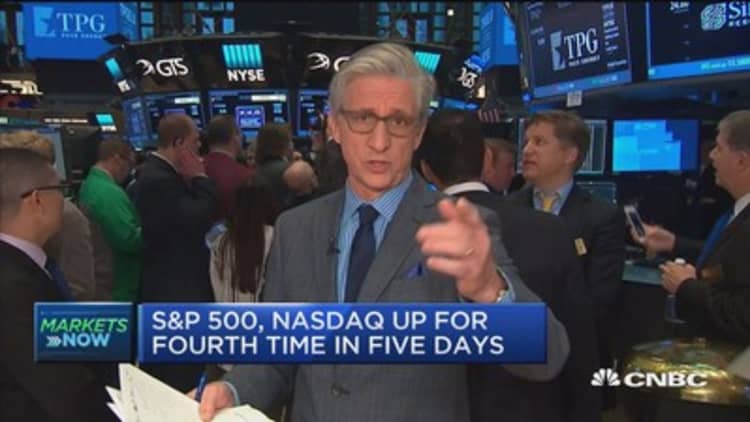
The S&P 500 and the Nasdaq composite indexes closed at record levels on Friday as investors looked ahead to a key European election.
Both indexes, along with the Dow Jones industrial average, rose sharply heading into the close after hovering around the flatline for most of the session. Shares of Apple closed at a record high, helping lift the Dow and Nasdaq.
The Dow, S&P and Nasdaq also posted slight weekly gains and traded in a narrow range for most of the week.
"This narrow trading range tells us a few things," said Art Hogan, chief market strategist at Wunderlich Securities. "First, we went up 2 percent the week before. Second, we're near all-time highs and finally, earnings season is over and we now shift our attention to macro issues."
Major indexes this week
Source: FactSet
French citizens will elect a new president on Sunday. Centrist Emmanuel Macron is widely expected to defeat far-right candidate Marine Le Pen. Macron, contrary to Le Pen, is a staunch supporter of keeping France in the European Union.
The euro surged against the dollar following the first round of the election and has hovered around $1.099 since.
"I think there will be a reaction to the upside if Macron wins, but it won't be as significant," said Peter NG, senior FX trader at Silicon Valley Bank.
U.S. equities traded in a narrow range for most of Friday after the Labor Department reported solid jobs growth for April.
The U.S. economy added 211,000 jobs in April and the unemployment rate fell to 4.4 percent. Economists polled by Reuters expected jobs growth of 185,000 and for the unemployment rate to hit 4.5 percent.
"The market reaction was a little muted. I think there's just caution out there," said JJ Kinahan, chief market strategist at TD Ameritrade. "People are saying there's no caution as seen on the Vix, but where you are seeing caution is in people not going out and buying everything at these levels."
Average hourly wages, meanwhile, rose 0.3 percent.
"It was a mixed report. The jobs figure came in above expectations, but the market is still concerned about the softness in wages," said Jon Adams, senior investment strategist at BMO Global Asset Management.
Wall Street had been looking forward to this jobs report after March's numbers were lackluster. Investors also wanted to gauge whether the Federal Reserve could stay on its current path towards monetary policy normalization.
"Today's numbers from the jobs report represent a strong bounce-back following the disappointing figures recorded the month prior and is [a] testament to a growing economy," said Kully Samra, managing director at Charles Schwab.
"With the Fed hitting the pause button in May, the recovery in today's employment data gives weight to the prospect of a further rate hike in June and the possibility of two or three more this year," Sarma said.
The Fed held interest rates steady earlier this week, but hinted at the possibility of a June rate hike. Market expectations for a rate hike next month were 78.5 percent on Friday, according to the CME Group's FedWatch tool.
U.S. equity futures rose slightly after the jobs data were released, while Treasury yields traded mixed. The benchmark 10-year note yield fell to 2.353 percent after a brief rise following the data release. The two-year note yield, meanwhile, rose to 1.32 percent.
"It was a good number," said Robert Tipp, chief investment strategist at PGIM Fixed Income. "I think the bond market had priced in an upside surprise after [March's] depressed number."
Wall Street also kept an eye on oil prices as they tried to rebound from a five-month low. West Texas Intermediate futures for June rebounded Friday, closing 1.54 percent higher at $46.22 per barrel.
Crude's bounce helped lift energy stocks about 1 percent on Friday.
Major U.S. Indexes
The Dow Jones industrial average rose 55.47 points, or 0.26 percent, to close at 21,006.94, with DuPont leading advancers and IBM the biggest decliner.
The rose 9.77 points, or 0.41percent, to end at 2,399.29, with energy leading nine sectors higher and financials lagging.
The Nasdaq advanced 25.42 points, or 0.42 percent, to close at 6,100.76.
About three stocks advanced for every decliner at the New York Stock Exchange, with an exchange volume of 830.48 million and a composite volume of 3.46 billion at the close.
The CBOE Volatility Index (VIX), widely considered the best gauge of fear in the market, traded near 10.7.


